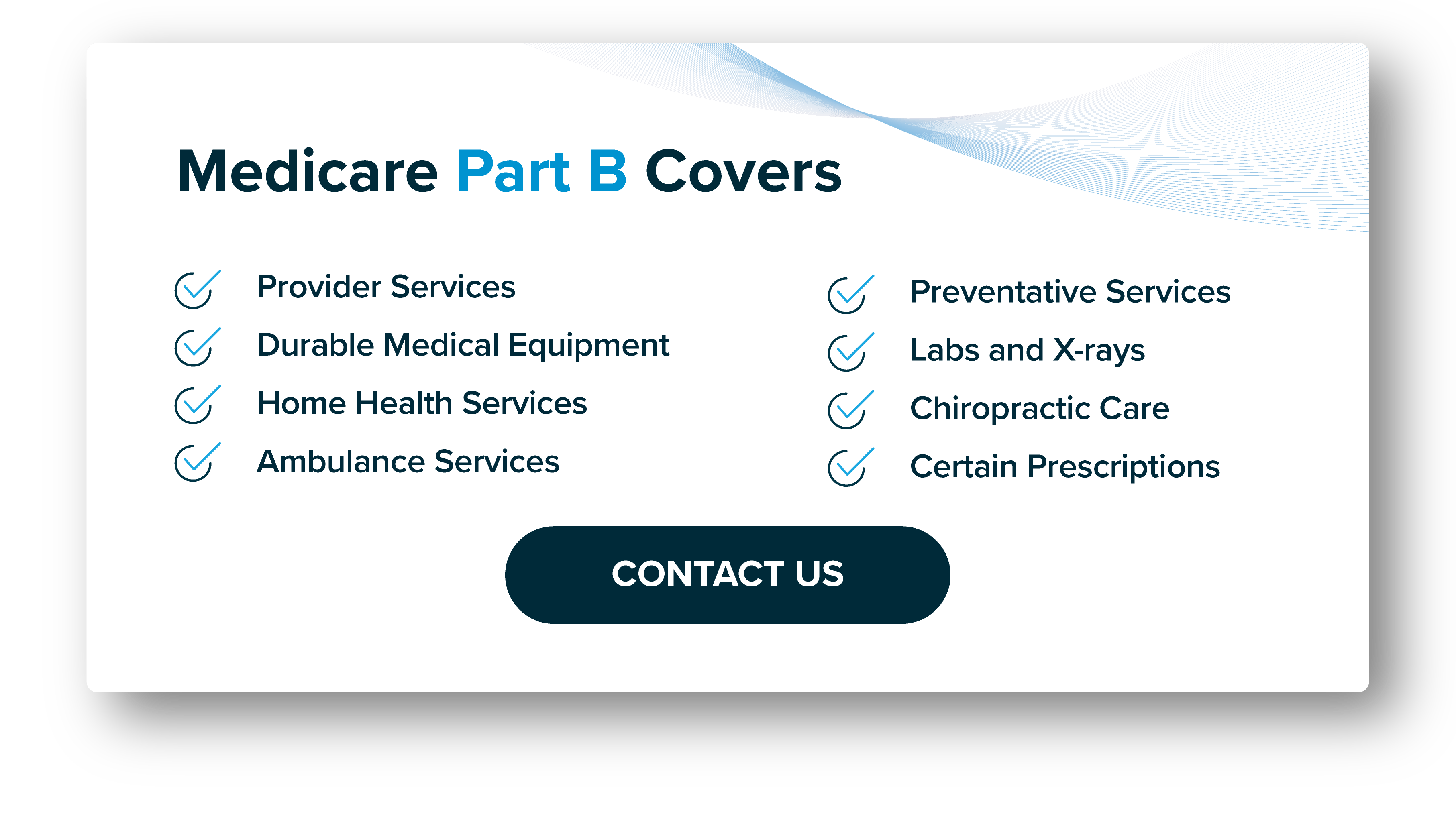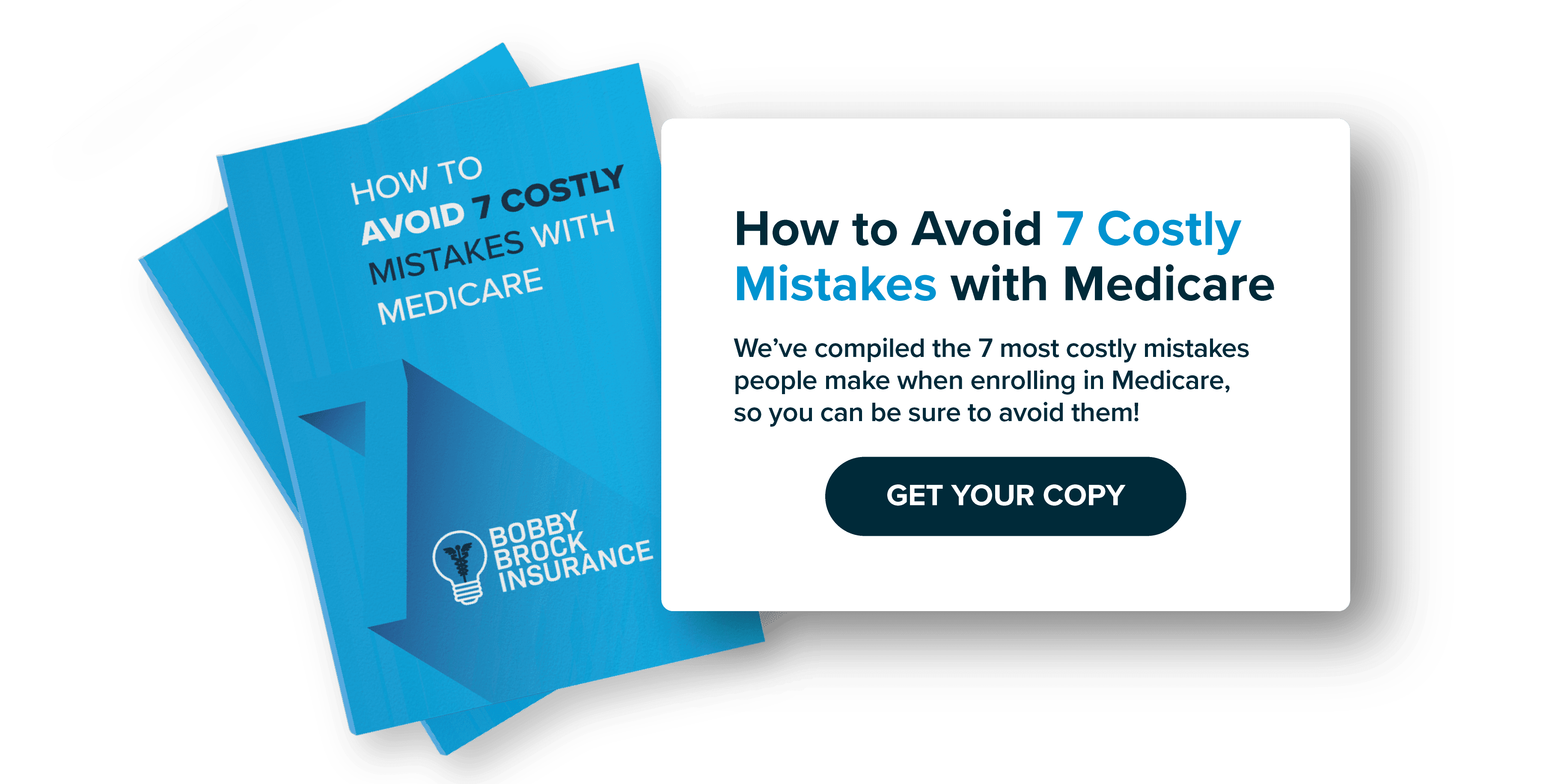Medicare Part B
Part B is the second half of Original Medicare, which consists of Parts A and B. Medicare Part B is listed as “Medical” on your Medicare ID card, and it’s often referred to as outpatient insurance or medical insurance.
Part B is primarily designed to cover two types of services: medically-necessary services and preventive services. These services include care received from doctors and other healthcare providers, as well as many preventive services like screenings, vaccines, and yearly wellness visits.

What does Medicare Part B cover?
Provider services: Care received in a doctor’s office or other outpatient setting that is deemed medically necessary is covered by Part B.
- Durable medical equipment (DME): Part B covers equipment that serves a medical purpose, can withstand repeated use, and is appropriate for home use.
- Home health services: Part B covers home health care services, skilled nursing, and therapy care if you are homebound.
- Ambulance services: Part B covers emergency transport by ambulance. It also offers limited coverage for non-emergency transportation if there is no other safe alternative, as long as it is medically necessary.
- Preventive services: Part B covers outpatient physical, occupational, and speech therapy that is administered by an approved therapist. It also offers many types of screenings, counseling, wellness programs, and vaccines.
- Labs and x-rays: Part B covers all lab tests and diagnostic images ordered by a physician.
- Chiropractic care: Chiropractic benefits are limited under Part B, but it does offer coverage when these services are needed to fix subluxation of the spine.
- Certain prescriptions: Some prescriptions are covered by Part B. Most drugs that fall under Part B are administered via injection by a physician. Common prescriptions covered by Part B include immunosuppressants, dialysis, anti-cancer drugs, and some antiemetic drugs.
How much does Medicare Part B cost?
Medicare Part B has a monthly premium. The Centers for Medicare and Medicaid Services (CMS) decides what the standard premium should be each year. In 2024, the standard Medicare Part B premium amount is $174.70.
Most beneficiaries pay the standard premium, but people with higher incomes can pay more. If your modified adjusted gross income is above a certain threshold, you will be subject to IRMAA, the Income-Related Monthly Adjustment Amount. IRMAA has several levels, so your Part B premium will be determined by which income bracket you fall into. The Social Security Administration uses your income from two years prior to calculate your Part B premium.
You can also apply to reduce your Part B premium. Medicare Savings Programs (MSP) offer financial assistance to those with limited income and resources. You may get some or all of your premiums and cost-sharing amounts taken care of if you qualify for an MSP.
Your Part B premium will be automatically deducted from your Social Security or Railroad Retirement Board benefits, assuming you are receiving them. If you have not yet signed up for those benefits, you can make quarterly or monthly payments online.
The premium isn’t the only cost you’ll have with Part B. You will also be responsible for an annual deductible, copayments, and coinsurance costs.
CMS sets the Part B deductible, which is currently $240. You must meet this deductible before Part B begins to pay for services. However, some preventive care does not apply to the deductible. The deductible resets every January 1.
Once you’ve met the annual deductible, Medicare Part B covers 80% of all Medicare-approved services. You are left with the remaining 20%. While this is good coverage and sounds typical to what you were probably used to under a group health insurance plan, there is a big difference with Medicare. Medicare does not offer a stop-loss point or out-of-pocket limit. This is why we almost always recommend adding a Medicare Supplement or Medicare Advantage plan rather than having only Original Medicare.
One last cost to consider for Part B: excess charges. An excess charge is an amount beyond the standard deductible and 20% coinsurance. Doctors and other healthcare providers can charge an additional 15% on top of the Medicare-approved fee for a service. That extra 15% is referred to as the Part B excess charge, and you are responsible for paying it. This is another reason we recommend adding supplemental coverage.
Enrolling in Medicare Part B
Most people sign up for both Part A and Part B at the same time, usually around their 65th birthday. If you are “aging into” Medicare, you become eligible when you turn 65. Younger individuals who have End-Stage Renal Disease (ESRD), amyotrophic lateral sclerosis (Lou Gehrig’s disease), or have been on disability for 24 months are also eligible to enroll in Medicare.
You can enroll in Part B during your Initial Enrollment Period (IEP), which begins three full months before your birthday month and lasts for a total of seven months. If you enroll before your birthday month, coverage can begin as early as the first day of the month you turn 65.
Sometimes, it makes sense to postpone your Medicare enrollment. If you or your spouse are still working and have coverage through the employer, it may be a better option to keep that coverage. Before you make this decision, check to see if your employer-sponsored plan is creditable. If it’s not, you can’t delay Medicare, and you’ll be penalized if you do so. The Medicare advisors at Bobby Brock Insurance can help you decide which is the better option if you find yourself in this situation.
If you are already receiving Social Security or Railroad Retirement Benefits at least four months before your 65th birthday, you’ll be automatically enrolled in Parts A and B. Your Medicare ID card will arrive in the mail about three months before you turn 65. If you wish to postpone your enrollment, you’ll need to fill out the form they send with your card to let them know you are declining coverage.
If you are not receiving retirement benefits, you can enroll in Medicare online at SSA.gov, in person at your local Social Security Administration office, or over the phone.
Part B Frequently Asked Questions
Have more questions about Medicare Part B? Take a look below at the most common questions we get asked about Part B.
- What affects Medicare Part B premiums? Your income will impact your Part B premiums. While most beneficiaries pay the standard premium, you can pay more if you have a high income. This extra amount is referred to as the Income-Related Monthly Adjustment Amount (IRMAA). On the other hand, if you have a limited income, you may qualify for a Medicare Savings Program that will help pay your Medicare premiums.
- What does Medicare Part B not cover? Part B does not cover inpatient hospital costs, routine dental care, preventive vision and hearing services, or most prescription drugs. It also does not cover any cosmetic medical treatments.
- Why would you decline Medicare Part B? You may decline Part B if you or your spouse are still working and have creditable health insurance through your employer. As long as the insurance plan is creditable, you can postpone Medicare enrollment without incurring any late-enrollment penalties.
- Is Medicare Part B free? No, Medicare Part B is not free. You will have a monthly premium, as well as cost-sharing amounts.












